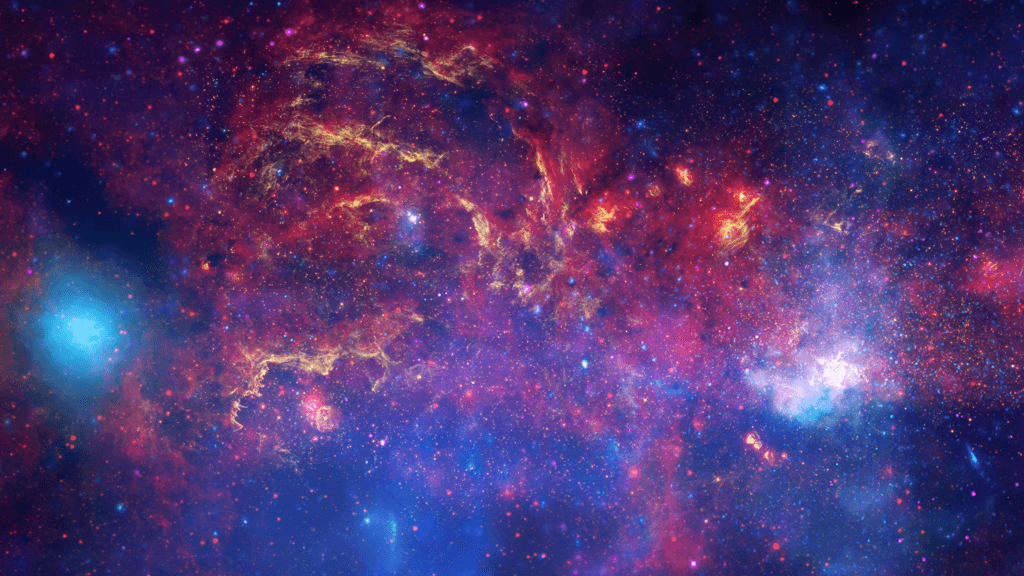Astronomers have spotted a figurative “stellar fountain of youth” at the heart of the Milky Way. Situated around our galaxy’s supermassive black hole, it’s an area that holds a shockingly high number of young stars and regions of ice water.
The discovery was made by an international team of researchers, led by University of Cologne Institute of Astrophysics researcher Florian Peißker, that examined a star cluster close to our galaxy’s central supermassive black hole, Sagittarius A* (Sgr A*).
The cluster, designated IRS13, was first identified over two decades ago, but had been difficult to assess how old its stellar components are. Using data collected by a wide range of telescopes over many years, however, Peißker and colleagues finally found the stars in IRS13 to be much younger than expected. The stars in IRS13 appeared to be around 100,000 years old, which is extremely young in cosmic terms. For instance, our “middle-aged” star is around 4.6 billion years old, meaning the sun is 46,000 times older than the stars of IRS13.
“The analysis of IRS13 and the accompanying interpretation of the cluster is the first attempt to unravel a decade-old mystery about the unexpectedly young stars in the Galactic Center,” according to Peißker. “In addition to IRS13, there is a star cluster, the so-called S-cluster, which is even closer to the black hole and also consists of young stars. They are also significantly younger than would be possible according to accepted theories.”
Related: Our Milky Way galaxy was not always a spiral. Here’s how it changed shape
The discovery of such an abundance of youthful stellar bodies at the heart of the Milky Way is shocking because it was previously thought that high-energy radiation and immense tidal forces generated by gravity in this central region (and near Sgr A*, which has a mass equivalent to 4.3 million suns) would disrupt star formation. That should have prevent young stars from gathering around Sgr A* and in the vicinity of the galactic center.
This isn’t the only shock the heart of the Milky Way has delivered to scientists recently.
In a separate study, the James Webb Space Telescope (JWST) was used to discover water ice at the Milky Way’s galactic center. This is connected to the recently found wealth of young stars in the region because water ice is commonly found in disks of dusty material that surround young stars called protoplanetary disks. Water ice also indicates the unexpected youth of stars around Sgr A*.
Peißker and his team think that IRS13 may have experienced a turbulent formation, theorizing that the star cluster was pushed toward Sgr A*. The cause of this migration could be friction generated by interactions with dust and gas that lies between stars — the interstellar medium. Or, it could be collisions between IRS13 and other star clusters.
This movement would have resulted in gas and dust piling up at the leading edge of the star cluster, almost like how a working snow plow builds up a wedge of icy material while sweeping the streets. Stars form in overly dense regions of gas and dust, so this compression of material would trigger the birth of new stars in IRS13.
Once IRS13 was close enough to Sgr A*, the cluster with areas of active star birth would have then been captured by the immense gravity of the supermassive black hole.
The team now intends to study IRS13 further in order to determine the effects supermassive black holes like Sgr A* can have on their surroundings and regions of galaxies not in their immediate vicinity.
“The star cluster IRS13 seems to be the key to unraveling the origin of the dense star population at the center of our galaxy,” team member and Masaryk University scientist Michal Zajaček explained. “We have gathered extensive evidence that very young stars within the range of the supermassive black hole may have formed in star clusters such as IRS13.
“This is also the first time we have been able to identify star populations of different ages — hot main sequence stars and young emerging stars — in the cluster so close to the center of the Milky Way.”
The team’s research was published Oct. 10 in the Astrophysical Journal

